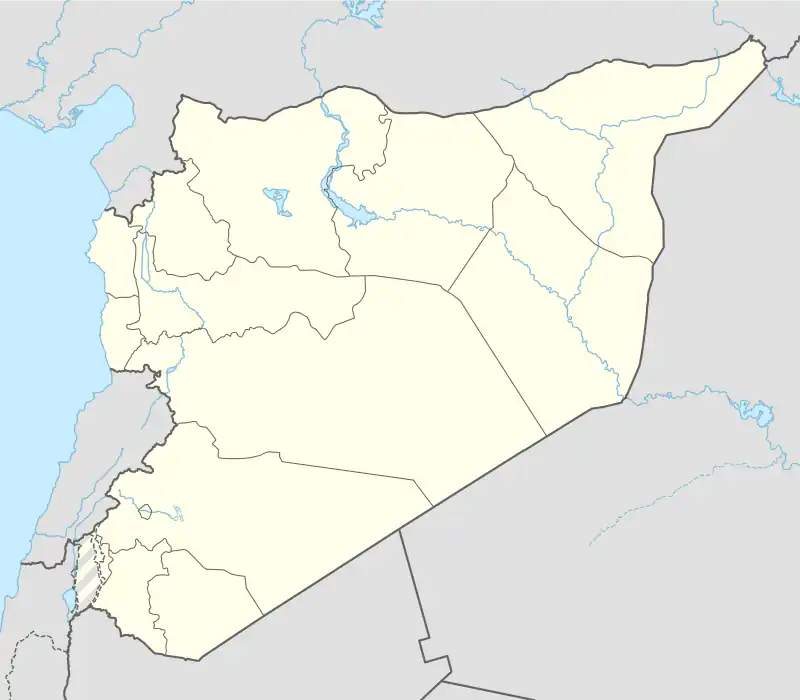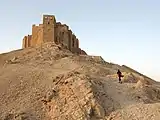| Palmyra Castle | |
|---|---|
قلعة فخر الدين المعني | |
| Palmyra, Syria | |
.jpg.webp) View of the castle | |
 Fakhr-al-Din al-Ma'ani Castle | |
| Coordinates | 34°33′46″N 38°15′26″E / 34.5627417°N 38.2571059°E |
| Type | Castle |
| Site information | |
| Controlled by | Syrian Army |
| Open to the public | Inaccessible (in a war zone) |
| Condition | Largely intact but damaged |
| Site history | |
| Built | 13th century |
| Built by | Mamluks |
| Battles/wars | Syrian Civil War |
| Type | Cultural |
| Criteria | i, ii, iv |
| Designated | 1980 (4th session) |
| Part of | Site of Palmyra |
| Reference no. | 23 |
| Region | Arab States |
| Endangered | 2013–present |
Palmyra Castle, also known as Fakhr-al-Din al-Ma'ani Castle (Arabic: قلعة فخر الدين المعني) or Tadmur Castle, is a castle overlooking Palmyra in the province of Homs, Syria.
The castle is thought to have been built by the Mamluks in the 13th century[1] on a high hill overlooking the historic site of Palmyra, and is named for the Druze emir Fakhr-al-Din II, who extended the Druze domains to the region of Palmyra during the 16th century.
The site of the castle and Palmyra in 1980 became a UNESCO World Heritage Site in recognition of the monumental ruins of a great city, which was one of the most important cultural centres of the ancient world. The site was designated a national monument in Syria and a buffer zone was established in 2007.[2]
The castle lying on raised bedrock was a well defended position for a fortification with thick and high walls, which was also surrounded by a moat that had only one access available through a drawbridge.
The historic site was placed on the list of World Heritage Sites in Danger in 2013 due to the ongoing Syrian Civil War.[3]
The castle was captured by the Islamic State of Iraq and the Levant during the Palmyra offensive in May 2015.[4] It was recaptured by Syrian government forces in another offensive in March 2016.[5] Retreating ISIS fighters blew up parts of the castle, including the stairway leading to the entrance, causing extensive damage. The basic structure is still intact, and Syrian director of antiquities Maamoun Abdelkarim stated that the damage is repairable and the castle is to be restored.[6] The castle was captured by ISIL once again in December 2016.[7] However, the Syrian Army captured it again after an assault on 1 March 2017.[8][9][10]
Gallery
 Way to the top
Way to the top Passage
Passage Walls
Walls Rooftop
Rooftop
See also
References
- ↑ Warwick Ball, Syria: A Historical and Architectural Guide, 1994. ISBN 1-56656-665-7. p. 228
- ↑ "Site of Palmyra". UNESCO World Heritage Centre. Retrieved 18 October 2013.
- ↑ "Syria's priceless heritage under attack". BBC News. Retrieved 18 October 2013.
- ↑ Stromme, Lizzie (26 March 2016). "Ruthless Vladimir Putin helps Syrian forces SEIZE ancient Palmyra Castle from evil ISIS". Daily Express. Archived from the original on 28 March 2016.
- ↑ "Islamic State loses Palmyra citadel to Syrian army". Times of Malta. 25 March 2016. Archived from the original on 27 March 2016.
- ↑ Said, H.; Raslan, Rasha; Sabbagh, Hazem (26 March 2016). "Palmyra Castle partially damaged due to ISIS acts, plans to restore it to its former glory". Syrian Arab News Agency. Archived from the original on 27 March 2016.
- ↑ "Russian warplanes target IS in Tadmur and IS takes almost full control on the city". Syrian Observatory for Human Rights. 10 December 2016. Archived from the original on 11 December 2016.
- ↑ "Breaking: Syrian Army on verge of recapturing Palmyra [Map + Video]". Al-Masdar News. 1 March 2017. Retrieved 1 March 2017.
- ↑ "Syrian army advances to outskirts of IS-held Palmyra". The Associated Press. Digital Journal. 1 March 2017. Retrieved 1 March 2017.
- ↑ "ISIS in deep trouble as the Syrian Army enters Palmyra city". Al-Masdar News. 1 March 2017. Retrieved 1 March 2017.
